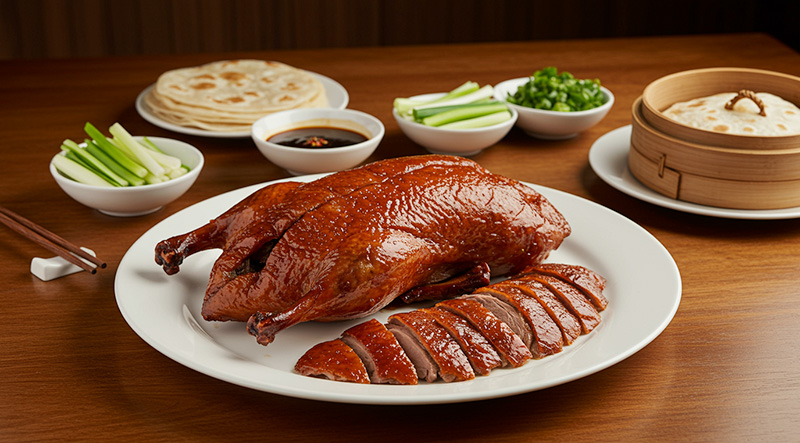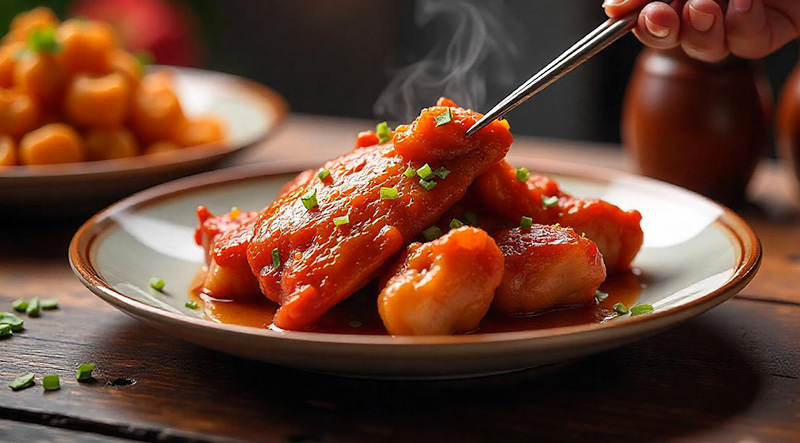Crispy, glossy, and steeped in imperial tradition, Peking Duck is China’s most iconic culinary masterpiece that turns every bite into a royal experience. With its crackling skin roasted to golden perfection and succulent meat sliced with precision, this dish is a dazzling harmony of texture and flavor. Wrapped in a delicate pancake with sweet hoisin sauce, crisp scallions, and fresh cucumber, it’s more than a meal—it’s a timeless ritual that captures the elegance and depth of Chinese cuisine in every bite. Read More...
The History of Peking Duck: A Royal Dish Through the Ages:
Peking Duck, with its glossy, crisp skin and delicate preparation, is one of the most celebrated dishes in Chinese cuisine. This culinary icon has delighted emperors, enchanted foreign dignitaries, and earned a permanent place on the world’s gastronomic stage. But the story behind the dish goes far deeper than its signature golden sheen—it is a tale of imperial grandeur, evolving techniques, and cultural pride that spans centuries.
Imperial Beginnings: From Nanjing to Beijing:
The roots of Peking Duck trace back to the Yuan Dynasty (1271–1368), when roasted duck was already gaining popularity in imperial courts. At the time, the capital of China was in Nanjing, and a dish known as shaoyazi (烧鸭子)—roast duck—was served to royalty. These early versions laid the groundwork for what would become the Peking Duck we know today.
When the Ming Dynasty moved the imperial capital to Beijing (then Peking) in the early 15th century, the dish followed. It was during this period that the technique of roasting duck over an open flame in a brick oven was perfected, creating the now-signature crisp skin and juicy meat. The dish became a court delicacy, reserved for the elite and served during banquets and state occasions.
A Refined Ritual: The Art of the Duck:
By the Qing Dynasty (1644–1912), Peking Duck had evolved into a highly ceremonial dish, with complex preparation techniques and dedicated duck farms raising the prized White Beijing Duck breed. These ducks were force-fed to ensure a plump body, then air-dried and glazed with a maltose syrup before roasting—creating the dish’s iconic glossy, crisp skin.
Carving the duck became an art form in itself. Traditionally, a skilled chef would slice the duck tableside into exactly 108 pieces, often with each slice bearing both skin and meat. It was served with thin pancakes, spring onions, cucumber, and sweet bean or hoisin sauce—meant to be rolled into delicate wraps and eaten by hand.
Global Fame and Modern Revival:
Though it was once a dish of emperors, Peking Duck eventually made its way into the public sphere. In the 19th and 20th centuries, restaurants like Quanjude and Bianyifang in Beijing began serving it to commoners, solidifying its place in everyday Chinese dining culture.
By the time China opened up to the world in the 20th century, Peking Duck had become a symbol of Chinese hospitality and sophistication, frequently served at diplomatic banquets and to visiting dignitaries—including Richard Nixon during his historic 1972 visit to China.
Today, Peking Duck is enjoyed not only in Beijing but in Chinese restaurants worldwide. While modern versions may simplify the preparation, the reverence for the dish’s tradition remains.
A Dish That Embodies China’s Culinary Legacy:
Peking Duck is more than just a meal—it’s a living piece of Chinese history. It reflects the meticulous attention to detail, the harmony of flavor and texture, and the deep cultural pride embedded in Chinese cuisine. From imperial feasts to modern tables, Peking Duck continues to be a golden emblem of China’s culinary excellence—crisped to perfection and wrapped in centuries of tradition.
Clean and Prepare the Duck:
Glaze and Dry the Skin:

Roast the Duck:
Tip: Baste the duck with a mixture of honey, soy sauce, and vinegar once or twice during the final stage for extra shine.

Carve and Serve:
Bonus Tip:
Serve with a light soup made from the duck bones or a side of stir-fried greens for a full meal experience.
The total preparation and cooking time for Peking Duck is approximately 18 to 24 hours, primarily due to the essential step of air-drying the duck overnight to achieve crispy skin. Active preparation—including cleaning the duck, applying the spice rub and glaze, and setting it up for drying—takes about 30 to 45 minutes. After drying in the fridge for 12 to 18 hours, the roasting process takes around 2 hours, including flipping the duck and crisping the skin in the final stage. Allow an additional 10 minutes for resting and 15 minutes for carving and plating before serving.c
A single serving of Peking Duck, based on the recipe provided and assuming the duck serves about 6 people, contains approximately 450 to 600 calories. This includes the roasted duck with its rich skin and tender meat (around 300–400 calories), a serving of hoisin sauce (about 50–70 calories), and two Mandarin pancakes (roughly 100–130 calories). The calorie count may vary depending on the fat rendered during cooking, the portion of skin consumed, and whether additional sauce or pancakes are used. Despite its indulgent profile, it's a satisfying meal often balanced with fresh vegetables like cucumber and scallions.



